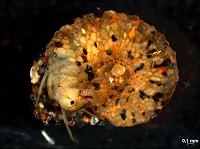Aquatic Macroinvertebrates as Indicators of Autodepuration Zones in the Colombian Andean Lotic System
Abstract
The self-purification process in a water system involves the ability to stabilize the presence of external agents in the water column through physical, chemical, and biological processes. This study aims to identify this self-purification zone in a Colombian Andean lotic system, using the community of aquatic macroinvertebrates (AM) as a biological indicator, supported by physical and chemical variables as additional information. To do so, the water quality prior to anthropogenic impact was established as a reference point, recording parameters such as pH, dissolved oxygen, and conductivity. Subsequently, data were collected after the perturbing event until values comparable to the initial point were reached, thus determining the potential recovery zone. Analyses were conducted at four sampling stations, where AM were collected, and physical and chemical parameters were recorded. Organisms were predominantly identified at the genus level, using taxonomic keys and visual guides. The sampling period spanned six months, from December 2009 to May 2010. When comparing the density of certain AM genera in stations before and after anthropogenic impact, it was observed that the self-purification zone is located at the fourth station, situated 2.2 km away from the disturbance point. In this area, the number of individuals is similar in some taxa compared to the reference station, with variations in their density. The results obtained are supported by the biological water quality (BMWP/Col index) and the majority of the analyzed physical and chemical variables.
Downloads
References
Baird, R. B. 2005. Biochemical Oxygen Demand (BOD). Pp 5000, 5-2 to 5-7. In: Eaton, D. A., Clesceri, L. S., Rice, E. W. and Greenberg, A. E. (Ed.). Standard methods for the examination of water y wastewater, 21 ed. American Public Health Association.
Barbosa, F. A. R., Padisák, J., Espíndola, E. L. G., Borics, G. y Rocha, O. 1999. The cascading reservoir continuum concept (CRCC) and its application to the river Tietê-basin, São Paulo State, Brazil. Theoretical Reservoir Ecology and Its Applications, 425-437. Disponible en: http://real.mtak.hu/3269/1/1014328.pdf
Branco, S. 1984. Limnología sanitaria, estudio de la polución de aguas continentales. Monografía No. 28. The General Secretariat of the Orgnanization of American State, São Paulo State, Brazil. 115 pp.
Bonada, N., Prat, N., Resh, V. H. y Statzner, B. 2005. Developments in Aquatic Insect Biomonitoring: A Comparative Analysis of Recent Approaches. Annual Review of Entomology, 51: 425-493. Disponible en: https://doi.org/10.1146/annurev.ento.51.110104.151124
Caicedo, O. y Palacio, J. 1998. Los macroinvertebrados bénticos y la contaminación orgánica en la quebrada La Mosca (Guarne, Antioquia, Colombia). Actualidades Biológicas, 20(69): 61-73.
Cairns, J., Albaugh, D. W. y Chanay, M. D. 1968. The Sequential Comparison Index: A Simplified Method for Non-Biologists to Estimate Relative Differences in Biological Diversity in Stream Pollution Studies. Journal WPCF, 40(9): 1607-1613.
Clements, W. H., Cherry, D. S. y Cairns Jr., J. 2009. Impact of Heavy Metals on Insect Communities in Streams: A Comparison of Observational and Experimental Results. Canadian Journal of Fisheries and Aquatic Sciences, 45(11): 2017-2025. Disponible en: https://doi.org/10.1139/f88-235
Domínguez, E. y Fernández, H. 2009. Macroinvertebrados bentónicos sudamericanos, sistemática y biología. Fundación Miguel Lillo, Tucumán, Argentina. 654 pp.
Domínguez, E., Molineri, C., Pescador, M., Hubbard, M. y Nieto, C. 2006. Ephemeroptera of South America. In Aquatic Biodiversity in Latin America. Pensoft Publishers, Sofia-Moscow. 640 pp.
Dresnack, R. y Dobbins, W. E. 1968. Numerical analysis of BOD and DO profiles. Journa of the Sanitary Engineering Division.J. Sanit. Engng Div., Am. Soc. Cir. Engrs, 94(SA5): 789-807. Disponible en: https://ascelibrary.org/doi/abs/10.1061/JSEDAI.0000891
Escobar Nieves, A. 2017. Estudio de las comunidades macrobénticas en el río Manzanares y sus principales afluentes y su relación con la calidad del agua. Actualidades Biológicas, 18(65): 45-60. Disponible en: https://doi.org/10.17533/udea.acbi.329878
Elliott, J. M. y McCafferty, W. P. 2006. Aquatic Entomology: The Fishermen’s and Ecologists’ Illustrated Guide to Insects and their Relatives. The Journal of Animal Ecology, 51(3): 1019-1020. Disponible en: https://doi.org/10.2307/4023
Epler, J. 2001. Identification Manual for the larval Chironomidae (Díptera) of North and South Carolina. A guide to the taxonomy of the midges of the southeastern United States, including Florida. North Carolina Department of Environment and Natural Resources, Tallahassee. 53 pp.
Giller, P. S. and Malmqvist, B. 1998. The biology of streams and rivers. Oxford University Press, Oxford. 43 pp.
Holdridge, L. R. 1967. Life zone ecology. Tropical Science Center, San Jose, Costa Rica. 140 pp.
Hynes, H. B. 1970. The ecology of running waters. University of Toronto Press, Toronto. 555 pp.
Longo, M., Zarnora, H., Guisande, C. y Ramírez, J. J. 2010. Dinámica de la comunidad de macroinvertebrados en la quebrada Potrerillos (Colombia) respuesta a los cambios estacionales de caudal. Limnetica, 29(2): 0195-210.
Machado, T. y Roldán, G. 1981. Estudio de las características físico-químicas y biológicas del río Anorí y sus principales afluentes. Actualid Biol., 10 (35): 3-19.
Marín, R. 1995. Análisis de aguas y ensayos de tratamiento: principios y aplicaciones. GPE S.A, Barcelona, España. 719 pp.
Marín, R. 2006. Fisicoquímica y microbiología de los medios acuáticos: Tratamiento y control de calidad del agua. Ediciones Díaz de Santos, Madrid, España. 418 pp.
Merrit, R. W., Cummins, K.W. y Berg, M. B. 2008. An introduction to the aquatic insects of North America, 4 ed. Kendall, Hunt Publishing Company, Dubuque. 1158 pp.
Tchobanoglous, G. 1991. Wastewater engineering: Treatment, disposal, and reuse. McGraw-Hill series in civil and environmental engineering. 1848 pp.
Moreno, Y. M., Ramírez, N. A., Caicedo, O. y Palacio, J. 2010. Dinámica multianual de los macroinvertebrados acuáticos bentónicos en la Quebrada Vegas de la Clara. Revista de Investigaciones, 29(2): 201-210.
Muñoz, I. y Prat, N. 1996. Effects of water abstraction and pollution on macroinvertebrate community in a Mediterranean river. Limnetica, 12(1): 9-16. Disponible en: https://www.limnetica.com/documentos/limnetica/limnetica-12-1-p-9.pdf
Nadal, A., Cossavella, A. y Larrosa, N. 2014. Determinación de la tasa de reaireación y modelación hidrodinámica de un tramo del río Tercero (Ctalamochita). Revista de La Facultad de Ciencias Exactas, Físicas y Naturales, 1(1): 49-50.
Oscoz, J., Campos, F. y Escala, M. C. 2006. Variación de la comunidad de macroinvertebrados bentónicos en relación con la calidad de las aguas. Limnetica, 25(3): 683-692.
Posada G., J. A., Roldán P., G. y Ramírez R., J. J. 2000. Caracterización fisicoquímica y biológica de la calidad de aguas de la cuenca de la quebrada Piedras Blancas, Antioquia, Colombia. Revista de Biología Tropical, 48(1): 59-70. Disponible en: https://revistas.ucr.ac.cr/index.php/rbt/article/download/18151/18386/
Prat, N., Toja, J., Solá, C., Burgos, M. D., Plans, M. y Rieradevall, M. 1999. Effect of dumping and cleaning activities on the aquatic ecosystems of the Guadiamar River following a toxic flood. Science of the Total Environment, 242 (1-3): 231-248. Disponible en: https://doi.org/10.1016/S0048-9697(99)00393-9
Prat, N., Ríos, B., Acosta, R. y Rieradevall, M. 2009. Los macroinvertebrados como indicadores de la calidad de las aguas. Pp 631-651. En: Domínguez, E., Fernández, H. R. (Ed). Macroinvertebrados bentónicos sudamericanos. Sistemática y biología. Fundación Miguel Lillo, Tucumán, Argentina. 654 pp.
Ramírez R., J. y Roldán P., G. 1989. Contribución al conocimiento limnológico y de los macroinvertebrados acuáticos de algunos ríos de la región del Urabá antioqueño. Actualidades Biológicas, 18(66): 113-121.
Reice, S. R. 2006. The Role of Substratum in Benthic Macroinvertebrate Microdistribution and Litter Decomposition in a Woodland Stream. Ecology, 61(3): 580-590. Disponible en: https://doi.org/10.2307/1937424
Resh, V. H. 2008. Which group is best? Attributes of different biological assemblages used in freshwater biomonitoring programs. Environmental Monitoring and Assessment, 138 (1-3): 131-138. Disponible en: https://doi.org/10.1007/s10661-007-9749-4
Roldán Pérez, G. 1996. Guía para el estudio de los macroinvertebrados acuáticos del Departamento de Antioquia. Fondo FEN, Bogotá, Colombia. 226 pp.
Roldán G., Posada, J. y Gutiérrez, J. 2001. Estudio limnológico de los recursos hídricos del Parque de Piedras Blancas. Academia Colombiana de Ciencias Exactas, Físicas y Naturales, Bogotá, Colombia. 81 pp.
Roldán, G. y Ramírez, J. 2008. Fundamentos de lignología neotropical, 2 ed. Editorial Universidad de Antioquia, Medellín, Colombia. 421 pp.
Smock, L. A. 1983. The influence of feeding habits on whole‐body metal concentrations in aquatic insects. Freshwater Biology, 13(4): 301-311. Disponible en: https://doi.org/10.1111/j.1365-2427.1983.tb00682.x
Springer, M., Hanson, P. y Ramírez, A. 2010. Macroinvertebrados de Agua Dulce de Costa Rica I. Revista de Biología Tropical, 58(4): 3-198. Disponible en: https://revistas.ucr.ac.cr/index.php/rbt/issue/view/1938
Streeter, H. W. y Phelps, E. B. 1958. A Study of the Pollution and Natural Purification of the Ohio River. United States Public Health Sevice, Washington, D.C. 61 pp.
Tank, L. J., Rosi-Marshall, E. J., Griffiths, N. A., Entrekyn, S. A. y Stephen, M. L. 2010. A review of allochthonous organic matters dinamycs and metabolism in stream. J. N. Am. Benthol. Soc., 29(1): 118-46. Disponible en: https://doi.org/10.1899/08-170.1
Tortorelli, M. C. y Hernández, D. A. 1995. Calidad de agua de un ambiente acuático sometido a efluentes contaminantes. Pp 217-230. En: Lopretto E. y Tell, G. (Ed). Ecosistemas de aguas continentales, metodología para su estudio, Tomo I. Ediciones Sur, La Plata, Argentina. 526 pp.
Voulgaropoulos, A., Fytianos, K., Apostolopoulou, A., y Gounaridou, X. 1987. Correlation of some organic pollution factors in water systems in Northern Greece. Water Research, 21(3): 253-256. Disponible en: https://doi.org/10.1016/0043-1354(87)90202-8
Walteros-Rodríguez, J. M. y Paiba-Alzate, J. E. 2010. Estudio preliminar de la comunidad de macroinvertebrados acuáticos en la reserva forestal Torre Cuatro. Boletín Científico. Centro de Museos. Museo de Historia Natural, 14(1): 137-149.
Zamora-Muñoz, C. y Alba-Tercedor, J. 2006. Bioassessment of Organically Polluted Spanish Rivers, Using a Biotic Index and Multivariate Methods. Journal of the North American Benthological Society, 15(3): 332-352. Disponible en: https://doi.org/10.2307/1467281
Zamora González, H. 2007. El Índice BMWP y la Evaluación Biológicas de la Calidad del Agua en los Ecosistemas Acuáticos Epicontinentales Naturales de Colombia. Revista Unicauca Ciencia, 4: 47-60.
Zúñiga de, C. M. C. 1985. Estudio de la ecología del río Cali con énfasis en su fauna bentónica como indicador biológico de calidad. Rev AINSA, 8: 63-85.

Copyright (c) 2023 Universidad del Cauca

This work is licensed under a Creative Commons Attribution-NonCommercial-NoDerivatives 4.0 International License.



.png)



